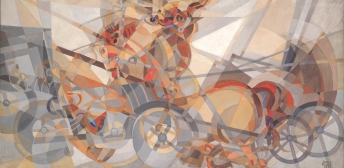Wednesday, January 18, 2017 - 12:00pm
Room 202, Frick Fine Arts Building
An Enduring Double Standard: Kineticism, Appropriation, and the Limits of Modernism
Rae Di Cicco

Following the redrawing of borders in Central Europe at the end of WWI, Viennese Kineticists aimed to synthesize the major formal innovations of avant-garde styles: Expressionism, Cubism, Futurism, and Constructivism. Although appropriation from within and beyond Europe was prevalent in early twentieth-century modernism, it has earned Kineticism labels such “derivative” and “nonintellectual.” Unlike comparable movements, where women were a present but smaller and less acclaimed portion of the constituents, the principal exponents of Kineticism were women – Erika Giovanna Klien, Marianne Ullmann, and Elisabeth Karlinsky. While Habsburg nostalgia and postwar amnesia may indeed play a role in Kineticism’s eradication from canonical accounts of Modernism, I argue that the unequal application of the dyad appropriation/derivation to female artists, as compared to their male counterparts working in other styles, drives the critique of their work as unworthy of scholarly inquiry. Presenting Kineticism simplistically as a provincial strain of Italian Futurism obfuscates the significant contribution of Kineticist artists to the development of modernism in Austria. Much was at stake, politically, socially, and aesthetically, in referencing Futurist dynamism and chronophotography in images of female bodies. The stylistic citation in these images evidence these women’s participation in critical debates about the core issues of modernity, such as scientific and artistic interest in the movement of the human body. This paper demonstrates that assumptions and attitudes toward women in the early twentieth century persist in the scholarly analyses of their work today, resulting in the obfuscation of fundamental issues of art making in twentieth-century Austria.
